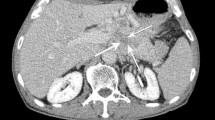Abstract
Purpose
The purpose of the study is to investigate the computed tomographic characteristic and clinical findings of gastric neuroendocrine carcinoma (G-NEC) to increase awareness of this disease.
Methods
Twenty-two patients with a diagnosis of G-NEC were identified through the PACS of our hospital from August 2010 to November 2014. The clinical data, computed tomography (CT) features, and pathology records were analyzed.
Results
Among the 22 patients, 21 were male (95.45%), and 1 was female (4.55%). The mean age was 63.5 years old. Positive rates of neuroendocrine markers were 77.28% for chromogranin A staining, 86.36% for synaptophysin staining. All cases were single lesions including 16 (72.73%) in the gastric fundus, 3 (13.64%) in the gastric body and 1 (4.55%) in the gastric angle. Additionally 2 (9.09%) were found in the gastric antrum. Gastric wall was local thickening in 15 cases, and mass formation in 7 cases, with the stenosis and deformation of the adjacent gastric cavity. The long-axis diameter of the lesions ranged from 1.2 to7.4 cm (mean diameter, 2.47 cm), and the long-axis diameter was <2 cm in 12 case, 2–7.4 cm in 10 cases. The radiodensity values of the lesions were homogeneous density in 15 cases ranging from 22 to 47 HU (mean 34 HU). An ulcer with an irregular base and slightly raised borders located in the stomach was seen in 19 cases. The CT images showed homogeneous enhancement in 15 cases and heterogeneous enhancement in 7 cases. Obvious enhancement was seen in two cases, moderate enhancement was seen in sixteen cases, and mildly enhancement was seen in four cases. The peak value occurred in the arterial phase in 5 cases and the peak value was seen in 17 cases in the portal phase. Eleven lesions invaded the gastric serosa, and lymphatic metastasis was observed in 21 cases, 8 of which were combined with liver metastasis. CT images revealed 2 cases of the liver metastasis had obvious enhancement.
Conclusion
The CT features regarding location, incidence rates of ulcer and enhancement pattern described in our findings are common in all malignant gastric tumors. Therefore, the diagnosis of G-NEC must be confirmed with pathological test.


Similar content being viewed by others
Abbreviations
- CT:
-
Computed tomography
- G-NEC:
-
Gastric neuroendocrine carcinoma
- NENs:
-
Neuroendocrine neoplasms
- NEC:
-
Neuroendocrine carcinoma
References
Oberndorfer S (1907) Karzinoide Tumoren des Dünndarms. Frankf Z Pathol 1:425–432
Li TT, Qiu F, Qian ZR, et al. (2014) Classification, clinicopathologic features and treatment of gastric neuroendocrine tumors. World J Gastroenterol 20(1):118–125
Scoazec JY, Couvelard A (2011) The new WHO classification of digestive neuroendocrine tumors. Ann Pathol 31(2):88–92
Jiang SX, Mikami T, Umezawa A, et al. (2006) Gastric large cell neuroendocrine carcinomas: a distinct clinicopathologic entity. Am J Surg Pathol 30(8):945–953
Miguchi M, Iseki M, Shimatani K (2012) Advanced gastric neuroendocrine carcinoma with an adenocarcinoma component. Case Rep Gastroenterol 6(1):52–57
Makis W, Ciarallo A, Hickeson M, et al. (2013) Gastric neuroendocrine carcinoma staged and followed with (18)F-FDG PET/CT–a report of 3 cases. Clin Nucl Med. 38(6):447–450
Watanabe N, Kato H, Shimizu M, et al. (2006) F-18 FDG PET imaging in gastric neuroendocrine carcinoma. Clin Nucl Med 31(6):345–346
Wang D, Zhang GB, Yan L, et al. (2012) CT and enhanced CT in diagnosis of gastrointestinal neuroendocrine carcinomas. Abdom Imaging 37(5):738–745
Xu X, Li J, Han X, et al. (2014) Clinical characteristics and prognostic factors of patients with gastric neuroendocrine carcinoma treated with radical surgery. Chin Med J (Engl) 127(13):2419–2422
Namikawa T, Oki T, Kitagawa H, et al. (2013) Neuroendocrine carcinoma of the stomach: clinicopathological and immunohistochemical evaluation. Med Mol Morphol. 46(1):34–40
Endo S, Dousei T, Yoshikawa Y, et al. (2012) Gastric neuroendocrine tumors in our institutions according to the WHO 2010 classification. Int Surg 97(4):335–339
Uchiyama C, Tamura S, Nakatsuka S, et al. (2012) Immunohistochemical consistency between primary tumors and lymph node metastases of gastric neuroendocrine carcinoma. World J Surg Oncol 10:115
Ishida M, Sekine S, Fukagawa T, et al. (2013) Neuroendocrine carcinoma of the stomach: morphologic and immunohistochemical characteristics and prognosis. Am J Surg Pathol 37(7):949–959
Kang SH, Kim KH, Seo SH, et al. (2014) Neuroendocrine carcinoma of the stomach: a case report. World J Gastrointest Surg 6(4):77–79
DelleFave G, Kwekkeboom DJ, Van Cutsem E, et al. (2012) ENETS consensus guidelines for the management of patients with gastroduodenal neoplasms. Neuroendocrinology 95(2):74–87
Karakoyun R, Demirci E, Karakoyun M, et al. (2014) Reliability of MDCT, with MPR and hydro-CT technique, in resectability and lymphnode staging of gastric cancer. Minerva Chir 69(3):129–140
Cidón EU, Cuenca IJ (2009) Gastric adenocarcinoma: is computed tomography (CT) useful in preoperative staging? Clin Med Oncol 3:91–97
Huang WL, Li YG, Lv YC, et al. (2014) Use of lectin microarray to differentiate gastric cancer from gastric ulcer. World J Gastroenterol 20(18):5474–5482
Wu J, Zhu H, Li K, et al. (2014) 18F-fluorodeoxyglucose positron emission tomography/computed tomography findings of gastric lymphoma: comparisons with gastric cancer. Oncol Lett 8(4):1757–1764
Gossios K, Katsimbri P, Tsianos E (2000) CT features of gastric lymphoma. Eur Radiol 10(3):425–430
Ovali GY, Tarhan S, Serter S, et al. (2005) Gastric stromal tumor. Diagn Interv Radiol 11(2):102–104
Acknowledgment
This work was supported the National Natural Science Foundations of China (81271573).
Author information
Authors and Affiliations
Corresponding author
Ethics declarations
Disclosures
We have no disclosures.
Rights and permissions
About this article
Cite this article
Liang, P., Wang, YX., Ren, XC. et al. Neuroendocrine carcinoma of the stomach: clinical features and CT findings. Abdom Radiol 41, 19–24 (2016). https://doi.org/10.1007/s00261-015-0593-7
Published:
Issue Date:
DOI: https://doi.org/10.1007/s00261-015-0593-7




